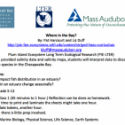
View The Resource
http://pie-lter.ecosystems.mbl.edu/sites/default/files/Where_in_the_Bay_Lesson_v02.pdf
http://pie-lter.ecosystems.mbl.edu/sites/default/files/Where_in_the_Bay_Lesson_v02.pdf
Time Required
1 45-60 min class period
1 45-60 min class period
Teaching Tips
Maps could be enlarged as could the fish cards to make things clearer for students in plotting salinity levels. 8 x 10 sheet too small. Teacher could enlarge maps to make things clearer for students in plotting salinity levels. Sheets could be laminated to use year after year.
Maps could be enlarged as could the fish cards to make things clearer for students in plotting salinity levels. 8 x 10 sheet too small. Teacher could enlarge maps to make things clearer for students in plotting salinity levels. Sheets could be laminated to use year after year.
About The Science
This guided inquiry encourages students to investigate how the distribution of several estuarine fish species will be affected by salinity predation and migration. Activity is a very superficial look at where certain fish species are distributed in the Chesapeake Bay according to their tolerance of salinity. Salinity data ends in 2000 - more recent data is surely available.
This guided inquiry encourages students to investigate how the distribution of several estuarine fish species will be affected by salinity predation and migration. Activity is a very superficial look at where certain fish species are distributed in the Chesapeake Bay according to their tolerance of salinity. Salinity data ends in 2000 - more recent data is surely available.
Pedagogy Annotation
Guided inquiry lesson encouraging students to use the Estuarine Marine Living Resource database to observe ranges of fish distribution along the Chesapeake Bay. Lots of flexibility built into the lesson to modify it for different age groups. Charts and cut outs need revising to make it easier for younger audiences. Activity is very simplistic.
Guided inquiry lesson encouraging students to use the Estuarine Marine Living Resource database to observe ranges of fish distribution along the Chesapeake Bay. Lots of flexibility built into the lesson to modify it for different age groups. Charts and cut outs need revising to make it easier for younger audiences. Activity is very simplistic.
Technical Details/Ease of Use
Lesson easily executed by using internet based resources and links. Powerpoint slide show to accompany lesson found: http://www.massaudubon.org/saltmarsh/striper/ labeled as Lesson 1 Where in the Bay. Print outs of maps and fish cards for students to use need to be enlarged in order for them to be useful.
Lesson easily executed by using internet based resources and links. Powerpoint slide show to accompany lesson found: http://www.massaudubon.org/saltmarsh/striper/ labeled as Lesson 1 Where in the Bay. Print outs of maps and fish cards for students to use need to be enlarged in order for them to be useful.










